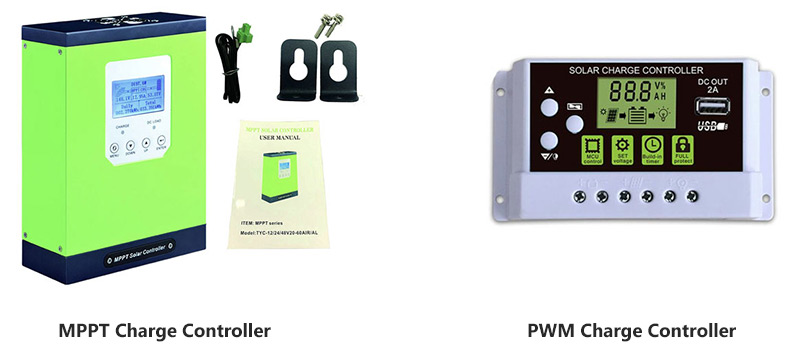In the solar off-grid system, the photovoltaic controller is to store the electricity generated by the photovoltaic module in the storage battery after transformation. In addition, it also has the functions of protecting the storage battery and preventing the battery from overcharging. At present, there are two main technical routes of the solar charge controller: Maximum power point tracking (MPPT) and pulse width modulation (PWM), both of which have its advantages and disadvantages, so users can select according to different scenarios.

MPPT solar charge controller
As the second generation solar controller, MPPT charge controller has one more inductor and power diode than PWM charge controller, so it has more powerful function.
On the one hand, it has the function of maximum power point tracking. During the battery charging, the solar module can output the maximum power unless the battery reaches saturation. On the other hand, its voltage range of the photovoltaic module is wide. With a power switch, inductor and circuit in the controller, the voltage of the module is 1.2-3.5 times that of the storage battery. For example, when the input voltage of the module is between 30V and 80V for 24V storage battery, one or two modules can be equipped with each series, while if the input voltage of module is between 60V and 110V for 48V storage battery, two or three modules can be equipped with each series.
PWM solar charge controller
In earlier stage, all the photovoltaic controllers are PWM. This kind of photovoltaic controller has a simple structure, which consists of a power main switch and capacitor, as well as drive and protection circuit. By the PWM duty cycle of the switch, the output voltage can be controlled.
The PWM solar charge controller has only one switch to connect the solar array and the battery panel. As the battery is fully charged gradually and the battery voltage increases, the PWM solar charge controller will gradually reduce the amount of power supplied to the battery. When the photovoltaic output is different, the maximum power output will prevail. In addition, the PWM controller has the function of charging and discharging management like a storage battery, which can prevent the battery from overcharging and discharging.
Since the PWM charge controller has only one switch to connect the solar module and the storage battery without inductance and other voltage divider in the middle, the voltage of the module is about 1.2-2.0 times that of the storage battery. For example, when the input voltage of the module is between 30V and 50V for 24V storage battery, and only one module can be equipped with each series, while if the input voltage of module is between 60V and 80V for 48V storage battery, only two modules can be equipped with each series.

How to choose MPPT controller and PWM solar charge controller?
Both MPPT and MPPT solar charge controller have their own advantages and disadvantages, so how to choose them depends on the design characteristics, cost and external environment of solar photovoltaic arrays. The following factors should be taken into account:
1. PWM charge controller has mature technology, simple and reliable circuit, as well as low price, but its utilization rate of the module is low, which is about 80% while MPPT controller is a solar controller with maximum power point tracking function, which has a BUCK circuit between the module and the storage battery, as well as 90% of utilization ratio of the module.
2. For small-scale off-grid system under 2kW, mainly used for lighting in poor and non-electric areas, such as remote mountainous areas and some poor countries in Africa, the users are very sensitive to the price, so it is suggested to use PWM charge controller and corrective wave inverters, so as to integrate the controller, inverters and storage battery, which has the advantages of simple structure, high efficiency, easy connection for users and low price. In addition, it can also drive light bulbs, little televisions and small fans.
3. MPPT charge controller is recommended for off-grid system more than 2kW, because it has high utilization ratio of the module, high efficiency and flexible configuration of modules. Generally speaking, there is no perfect technology, so it is better for users to take the advice of experts, thus ensuring that they choose the proper controller to meet their needs.
Inverter.com offers 20 amps, 30 amps...60 amps 12V/ 24V/ 48V MPPT solar charge controller and 10A, 20A...60A 12V/ 24V/ 48V PWM solar charge controller to choose. Buy a right charge controller for your off-grid system now!
